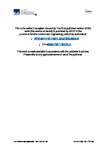Wave and Tidal Controls on Embayment Circulation and Headland Bypassing for an Exposed, Macrotidal Site
| dc.contributor.author | McCarroll, Jak | |
| dc.contributor.author | Masselink, Gerd | |
| dc.contributor.author | Valiente, NG | |
| dc.contributor.author | Scott, Tim | |
| dc.contributor.author | King, EV | |
| dc.contributor.author | Conley, Daniel | |
| dc.date.accessioned | 2018-09-24T15:15:16Z | |
| dc.date.issued | 2018-09 | |
| dc.identifier.issn | 2077-1312 | |
| dc.identifier.issn | 2077-1312 | |
| dc.identifier.other | ARTN 94 | |
| dc.identifier.uri | http://hdl.handle.net/10026.1/12415 | |
| dc.description.abstract |
<jats:p>Headland bypassing is the transport of sediment around rocky headlands by wave and tidal action, associated with high-energy conditions and embayment circulation (e.g., mega-rips). Bypassing may be a key component in the sediment budget of many coastal cells, the quantification of which is required to predict the coastal response to extreme events and future coastal change. Waves, currents, and water levels were measured off the headland of a sandy, exposed, and macrotidal beach in 18-m and 26-m depths for 2 months. The observations were used to validate a Delft3D morphodynamic model, which was subsequently run for a wide range of scenarios. Three modes of bypassing were determined: (i) tidally-dominated control during low–moderate wave conditions [flux O (0–102 m3 day−1)]; (ii) combined tidal- and embayment circulation controls during moderate–high waves [O (103 m3 day−1)]; and (iii) multi-embayment circulation control during extreme waves [O (104 m3 day−1)]. A site-specific bypass parameter is introduced, which accurately (R2 = 0.95) matches the modelled bypass rates. A 5-year hindcast predicts bypassing is an order of magnitude less than observed cross-shore fluxes during extreme events, suggesting that bypassing at this site is insignificant at annual timescales. This work serves a starting point to generalise the prediction of headland bypassing.</jats:p> | |
| dc.format.extent | 94-94 | |
| dc.language | en | |
| dc.language.iso | en | |
| dc.publisher | MDPI | |
| dc.subject | embayed beach | |
| dc.subject | sediment flux | |
| dc.subject | mega-rip | |
| dc.subject | Delft3D | |
| dc.title | Wave and Tidal Controls on Embayment Circulation and Headland Bypassing for an Exposed, Macrotidal Site | |
| dc.type | journal-article | |
| dc.type | Journal Article | |
| plymouth.author-url | https://www.webofscience.com/api/gateway?GWVersion=2&SrcApp=PARTNER_APP&SrcAuth=LinksAMR&KeyUT=WOS:000445858900021&DestLinkType=FullRecord&DestApp=ALL_WOS&UsrCustomerID=11bb513d99f797142bcfeffcc58ea008 | |
| plymouth.issue | 3 | |
| plymouth.volume | 6 | |
| plymouth.publication-status | Published online | |
| plymouth.journal | Journal of Marine Science and Engineering | |
| dc.identifier.doi | 10.3390/jmse6030094 | |
| plymouth.organisational-group | /Plymouth | |
| plymouth.organisational-group | /Plymouth/Faculty of Science and Engineering | |
| plymouth.organisational-group | /Plymouth/Faculty of Science and Engineering/School of Biological and Marine Sciences | |
| plymouth.organisational-group | /Plymouth/PRIMaRE Publications | |
| plymouth.organisational-group | /Plymouth/REF 2021 Researchers by UoA | |
| plymouth.organisational-group | /Plymouth/REF 2021 Researchers by UoA/UoA07 Earth Systems and Environmental Sciences | |
| plymouth.organisational-group | /Plymouth/Research Groups | |
| plymouth.organisational-group | /Plymouth/Research Groups/Marine Institute | |
| plymouth.organisational-group | /Plymouth/Users by role | |
| plymouth.organisational-group | /Plymouth/Users by role/Academics | |
| plymouth.organisational-group | /Plymouth/Users by role/Researchers in ResearchFish submission | |
| dcterms.dateAccepted | 2018-08-03 | |
| dc.rights.embargodate | 2018-9-29 | |
| dc.identifier.eissn | 2077-1312 | |
| dc.rights.embargoperiod | Not known | |
| rioxxterms.versionofrecord | 10.3390/jmse6030094 | |
| rioxxterms.licenseref.uri | http://www.rioxx.net/licenses/all-rights-reserved | |
| rioxxterms.type | Journal Article/Review | |
| plymouth.funder | Physical and biological dynamic coastal processes and their role in coastal recovery (BLUE-coast)::NERC | |
| plymouth.funder | Physical and biological dynamic coastal processes and their role in coastal recovery (BLUE-coast)::NERC |


